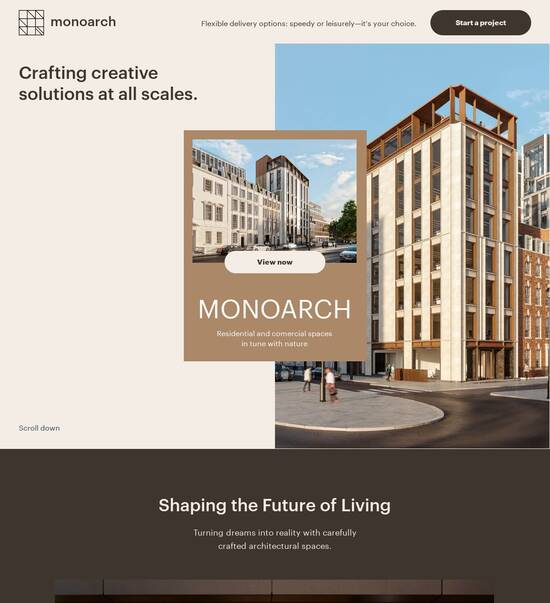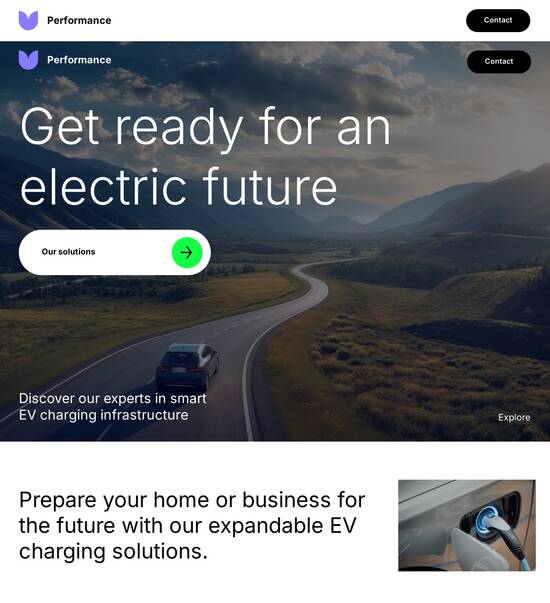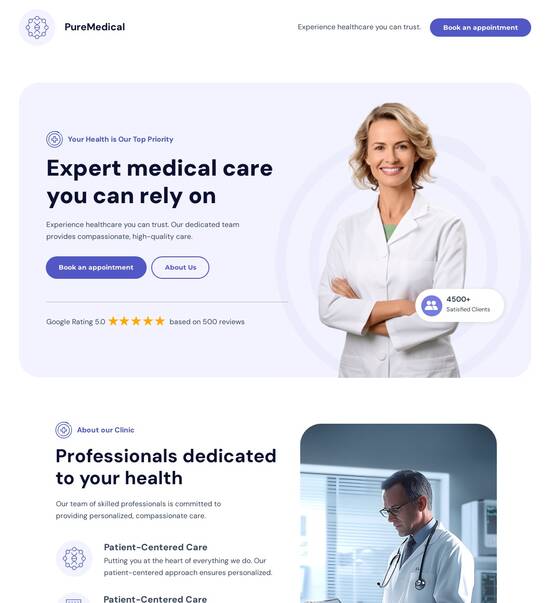
Landing page template for Residential Construction
Use TemplateAbout template
Conquer your niche with our high-converting landing page templates for your Residential Construction business. Let's boost conversion rates together!
Recommended templates

Easy to build without coding
With the intuitive drag-and-drop builder, anyone on your team can create high-converting pages without any knowledge of code or design. Make enhancements to your landing page with custom widgets using Javascript, HTML/CSS, or third-party scripts.

Multiple layouts for any industry and goal
Select from 500+ landing page layouts built to boost conversions across industry-specific scenarios. Customize them by adjusting fonts, adding images, and generating on-brand content with the AI assistant. Quickly scale with Instablocks® and Global Blocks that you can save, reuse, and update globally.

Loads fast and looks polished on any device
Every template is responsive, which means they present professionally on any device and load blazingly fast with our Thor Render Engine. You can also power them up with Google AMP technology to deliver an unparalleled mobile experience and drive higher conversions.

Robust analytics & experimentation
Get real-time updates and reporting across all your devices, showing the number of visitors, conversions, cost-per-visitor, and cost-per-lead. Launch AI-powered experiments, run A/B tests, and use heatmaps to analyze user behavior, then optimize your landing page to maximize conversions.







Easy to build without coding
With the intuitive drag-and-drop builder, anyone on your team can create high-converting pages without any knowledge of code or design. Make enhancements to your landing page with custom widgets using Javascript, HTML/CSS, or third-party scripts.
Multiple layouts for any industry and goal
Select from 500+ landing page layouts built to boost conversions across industry-specific scenarios. Customize them by adjusting fonts, adding images, and generating on-brand content with the AI assistant. Quickly scale with Instablocks® and Global Blocks that you can save, reuse, and update globally.
Loads fast and looks polished on any device
Every template is responsive, which means they present professionally on any device and load blazingly fast with our Thor Render Engine.
Robust analytics & experimentation
Get real-time updates and reporting across all your devices, showing the number of visitors, conversions, cost-per-visitor, and cost-per-lead. Launch AI-powered experiments, run A/B tests, and use heatmaps to analyze user behavior, then optimize your landing page to maximize conversions.
All the features you need to build landing page design for promoter residential project
Explore more featuresLearn how to build landing page construction
Frequently asked questions about construction landing page template
Leading the way in building high-performing landing pages





Template home builder: Your ultimate how-to guide
Creating a landing page template for residential construction is essential for engaging potential clients and generating leads. Instapage provides versatile and ready-to-use templates that can significantly enhance your marketing strategies across various channels. By employing these specialized templates, marketers in the construction industry can create targeted, high-converting landing pages that effectively showcase services and portfolios.
Benefits of using landing page templates
Utilizing professionally designed landing page templates offers several advantages for businesses in residential construction. These templates are crafted with industry best practices in mind, ensuring high conversion rates and seamless user experiences. Here's why they stand out:
- Instant deployment options — Quickly launch landing pages without starting from scratch, saving you time and effort.
- Customization capabilities — Tailor templates to align with your brand’s aesthetics and service offerings, ensuring a unique presentation.
- Mobile responsiveness — Templates are designed to perform optimally across devices, enhancing accessibility for potential clients.
Step 1: Selecting the right landing page template
Choosing the right template is crucial for effective customer engagement. Instapage offers a variety of pre-designed options tailored for residential construction businesses. When selecting a template, consider the following:
- Ensure it highlights key services prominently, as this will guide visitors to understand what you offer immediately.
- Select layouts that incorporate strong visuals of past projects, which can significantly enhance credibility.
- Opt for templates with built-in lead capture forms to streamline the process of gathering client information.
Step 2: Personalizing your landing page
After choosing a template, it’s time to make it your own. Personalization is key to connecting with your target audience. Focus on these aspects:
- Include dynamic text replacement to address specific audience segments and location-based offers directly.
- Integrate client testimonials and case studies that resonate with homeowners, building trust and authenticity.
- Use high-quality images and videos that display your construction projects to captivate and hold attention.
Step 3: Optimizing for performance
Once your landing page is live, ongoing optimization is critical. Use Instapage’s built-in analytic tools to identify areas for enhancement. Key optimization strategies include:
- Conduct A/B testing on different elements such as headlines, images, and calls to action to understand what performs best.
- Monitor heatmaps to learn how visitors engage with the page, adjusting elements that may be causing user drop-off.
- Continuously refine your landing page based on real-time data to maximize conversion rates.
By implementing these steps, you can create an impactful landing page that resonates with your audience and drives conversions in the residential construction sector. Instapage empowers marketers to enhance their strategies with high-quality templates tailored for success.
Ready to elevate your marketing game? Sign up for Instapage today and start transforming your digital campaigns with our powerful landing page solutions.
People also ask about Landing page template for Residential Construction
Landing page template for residential construction
Unpacking the essence of landing pages in the residential construction sphere
In the residential construction industry, landing pages serve as critical tools for capturing potential client interest. They act as a digital storefront, presenting information in a focused manner that speaks directly to the needs and concerns of homeowners looking to build or renovate. Unlike traditional web pages that often provide a broad range of information, landing pages are designed with a specific purpose—to convert visitors into leads by presenting targeted calls to action.
A tailored approach is vital in crafting landing pages for residential construction, as clients in this sector are often seeking reliability and quality. Such pages should reflect the unique services offered and create a sense of trust through professional design and content. Importantly, landing pages differ from traditional web pages in their streamlined focus; they eliminate distractions, condensing crucial information that motivates immediate action from potential clients.
The architectural blueprint: key features of landing page templates
When designing a landing page template for residential construction, several key features come into play. First and foremost is the visual appeal and aesthetic design. Utilizing architecture-centric visuals resonates with visitors, offering them a glimpse of what they can expect. Effective color palettes—such as earthy tones combined with bright accents—can evoke feelings of warmth and trust, crucial for building a connection with prospective clients.
High-quality images showcasing completed projects help to visually engage users.
Simplicity in layout ensures that essential information is easy to find and absorb.
Consistent branding elements improve brand recognition and trust.
Responsive design is another critical component. With a significant portion of searches for home construction being conducted on mobile devices, templates must be optimized for all screen sizes. Statistics indicate that nearly 60% of web traffic for residential construction occurs via mobile devices. Thus, a seamless mobile experience can dramatically enhance user engagement and conversion rates.
Moreover, incorporating SEO optimization options within landing page templates is essential. Residential construction firms should emphasize relevant keywords throughout their content to improve searchability. Best practices for on-page SEO, such as strategic placement of headings, metadata, and alt text for images, can significantly bolster organic reach.
Lastly, lead capture forms and functionality should be thoughtfully designed. Simple, user-friendly forms that capture essential client information are necessary for maximizing leads. Consideration around their placement—above the fold or in strategic locations throughout the page—can lead to increased form submission rates and ultimately drive more inquiries.
Specialized features for the construction industry
When it comes to specialized features, showcasing projects and integrating portfolios cannot be overlooked. A visual gallery that highlights past work not only presents quality but also instills confidence in potential clients. Descriptions accompanying each project provide context, showing the firm's approach to challenges and client needs, which is invaluable for decision-making.
Images of transformed spaces that communicate the quality of workmanship.
Case studies detailing specific client projects, which serve to build trust.
Incorporating client testimonials offers additional social proof that further enhances a firm’s credibility. Displaying feedback from satisfied customers on the landing page shows that others have successfully navigated similar projects. Strategies for effectively integrating these testimonials include prominently featuring quotes from clients and using visual elements like stars or badges to signify high ratings.
Implementing dynamic content features can also engage visitors more effectively. By utilizing HTML functionalities, landing pages can personalize the user experience, displaying content based on unique visitor attributes such as location, previous interactions, or specific interests. Case studies have shown that targeted messaging can substantially increase conversion rates by addressing potential clients' needs directly.
Including mapping and location features is also crucial. Demonstrating service areas on an interactive map helps clients understand the geographical scope of services offered. This can effectively alleviate concerns about distance or availability, positioning the firm as a viable option within their close vicinity.
Customization and flexibility of architecture website templates
Customization options in landing page templates are vital, especially for construction firms with unique offerings. User-friendly drag-and-drop functionality allows companies to personalize their templates easily, so they don’t have to be tech-savvy to create visually appealing pages. Highlighting design elements, such as font choices, color swatches, and modular sections, ensures that personalization is as intuitive as possible.
Easily changeable color schemes and image placeholders for quick adaptations.
Simple text input for headlines and body copy allows for tailored messaging.
Toggle options for features such as lightboxes or parallax scrolling enhance interaction.
Moreover, the versatility of templates across different sectors is essential. Architecture agencies might focus on aesthetics and portfolio showcase, while general construction companies should highlight services and customer engagement. Templates can adapt easily to both needs, as shown in case studies demonstrating how cross-functional templates boosted service inquiries across various business models in the construction industry.
Integration with existing digital assets is another consideration for construction companies. The ability to blend landing page templates seamlessly with current websites can avoid redundancies and provide a consistent user experience. Instances of successful integrations have shown how user navigation improves when landing pages work harmoniously with the overall site architecture.
The role of analytics in driving performance
To enhance performance, tracking visitor behavior through analytics tools is essential. Monitoring how visitors interact with the landing page—such as time spent on specific sections, click-through rates, and form submissions—can offer invaluable insights. Understanding visitor demographics and preferences enables construction firms to tailor their marketing efforts, ensuring that they target their audience with specific messaging that resonates.
Utilizing heatmaps to visualize user interactions on landing pages.
Analyzing traffic sources to determine effective platforms for outreach.
Setting up conversion goals to assess the effectiveness of different designs and content.
A/B testing is another critical method for optimization. Conducting tests on variations in web design, content, or form structures can reveal which elements lead to higher conversion rates. Architecture firms that have implemented A/B testing have recorded significant improvements in leads generated, demonstrating the value of systematic experimentation in landing page design.
Future-proofing residential construction landing pages
As we gaze into the future of residential construction landing pages, emerging technologies will undoubtedly influence web designs. For instance, the potential impact of virtual reality (VR) and augmented reality (AR) could transform how clients engage with construction firms. Imagine allowing clients to virtually step inside a model of their new home before any bricks are laid—this can significantly enhance client trust and excitement, making the design experience highly interactive.
Adopting these technologies will require firms to stay ahead of competitors by creating innovative landing pages that not only attract but also retain client attention. Incorporating 3D models or virtual walkthroughs can be compelling differentiators in a saturated marketplace. Strategic branding and thoughtful positioning within construction-focused landing pages can help firms establish a unique voice that resonates with potential clients.
Real-life success stories: transformations through enhanced landing pages
Case studies can illuminate the effectiveness of landing page templates in the residential construction sector. For instance, a local architecture firm's journey to revitalizing its landing page demonstrates the power of thoughtful design. Facing challenges like low visibility and ineffective lead generation, they implemented a refined landing page that emphasized their capabilities and showcased previous projects. Subsequently, metrics showed a 40% increase in client engagement and an uptick in inquiries.
Similarly, a construction company that underwent a digital transformation experienced remarkable results after revamping their landing page using customizable templates. By focusing on a user-friendly design and clear calls to action, they reported a 50% growth in lead generation and a substantial increase in revenue within just a few months. These real-life examples offer crucial insights into the positive impact that enhanced landing page templates can have on a firm's bottom line.
Comprehensive integration techniques for professional services
For multi-service firms in the construction industry, selecting the right website template can be a game-changer. These firms often offer a variety of services, and thus, adapting landing page templates to highlight diverse offerings can be crucial for driving inquiries. Case studies where cross-functional templates were utilized showcase an increase in service inquiries, as customers can easily navigate through services like design consultation, construction management, and renovation services without frustration.
Additionally, training and resources for a seamless transition into using new landing page templates is imperative. Companies need tools and training materials that will help their teams fully leverage the capabilities of their new templates. By emphasizing the importance of thorough training, firms can ensure operational readiness and avoid execution pitfalls, leading to an overall positive user experience.
Building a sustainable online presence for architecture firms
Maintaining a long-term online presence is crucial for architecture firms focusing on landing pages. Routinely updating content and visuals keeps the firm's digital footprint relevant and engaging to potential clients. Firms should consider implementing a content calendar to regularly refresh their landing pages with new projects, testimonials, or industry insights, helping to retain client interest over time.
Updating project galleries with recent work to demonstrate ongoing expertise.
Creating blog content discussing industry trends, enhancing value for visitors.
Engaging with feedback from clients to refine messaging and improve services.
Continuous learning from analytics allows firms to adapt their landing pages based on user feedback and market shifts. By regularly reviewing analytics data, firms can make informed adjustments to optimize content and design, ensuring that their landing pages remain effective in securing new client relationships.
Crafting the future of residential construction landing pages
Understanding evolving customer needs is paramount for the construction sector. Insights into shifting consumer preferences—such as an increasing demand for sustainability and smart home features—should be reflected in landing page content and design. Future trends will likely include greater emphasis on eco-friendly practices and technology integration within residential construction, making it essential for firms to adapt their messaging accordingly.
Inspiring innovation through collaboration between architecture firms and digital design agencies can redefine landing pages. By fostering a synergy between creative design and technical execution, firms can create landing pages that not only attract but also engage customers deeply, addressing their needs with precision and relevance.
Ready to skyrocket conversions?
Supercharge your ad campaigns with high-performing landing pages
Get started














